MIMO RADAR SIGNAL PROCESSING
CONTENTS
PREFACE
CONTRIBUTORS
1 MIMO Radar — Diversity Means Superiority
1.1 Introduction
1.2 Problem Formulation
1.3 Parameter Identifiability
1.3.1 Preliminary Analysis
1.3.2 Sufficient and Necessary Conditions
1.3.3 Numerical Examples
1.4 Nonparametric Adaptive Techniques for Parameter Estimation
1.4.1 Absence of Array Calibration Errors
1.4.2 Presence of Array Calibration Errors
1.4.3 Numerical Examples
1.5 Parametric Techniques for Parameter Estimation
1.5.1 ML and BIC
1.5.2 Numerical Examples
1.6 Transmit Beampattern Designs
1.6.1 Beampattern Matching Design
1.6.2 Minimum Sidelobe Beampattern Design
1.6.3 Phased-Array Beampattern Design
1.6.4 Numerical Examples
1.6.5 Application to Ultrasound Hyperthermia Treatment of Breast Cancer
1.7 Conclusions
Appendix IA Generalized Likelihood Ratio Test
Appendix 1B Lemma and Proof
Acknowledgments
References
2 MIMO Radar: Concepts, Performance Enhancements, and Applications
2.1 Introduction
2.1.1 A Short History of Radar
2.1.2 Definition and Characteristics of MIMO Radar
2.1.3 Uses of MIMO Radar
2.1.4 The Current State of MIMO Radar Research
2.1.5 Chapter Outline
2.2 Notation
2.3 MIMO Radar Virtual Aperture
2.3.1 MIMO Channel
2.3.2 MIMO Virtual Array: Resolution and Sidelobes
2.4 MIMO Radar in Clutter-Free Environments
2.4.1 Limitations of Cramér–Rao Estimation Bounds
2.4.2 Signal Model
2.4.3 Fisher Information Matrix
2.4.4 Waveform Correlation Optimization
2.4.5 Examples
2.5 Optimality of MIMO Radar for Detection
2.5.1 Detection
2.5.2 High SNR
2.5.3 Weak-Signal Regime
2.5.4 Optimal Beamforming without Search
2.5.5 Nonfading Targets
2.5.6 Some Additional Benefits of MIMO Radar
2.6 MIMO Radar with Moving Targets in Clutter: GMTI Radars
2.6.1 Signal Model
2.6.2 Localization and Adapted SNR
2.6.3 Inner Products and Beamwidths
2.6.4 SNR Loss
2.6.5 SNR Loss and Waveform Optimization
2.6.6 Area Search Rates
2.6.7 Some Examples
2.7 Summary
Appendix 2A A Localization Principle
Appendix 2B Bounds on R(N)
Appendix 2C An Operator Norm Inequality
Appendix 2D Negligible Terms
Appendix 2E Bound on Eigenvalues
Appendix 2F Some Inner Products
Appendix 2G An Invariant Inner Product
Appendix 2H Krönecker and Tensor Products
2H.1 Lexicographical Ordering
2H.2 Tensor and Krönecker Products
2H.3 Properties
Acknowledgments
References
3 Generalized MIMO Radar Ambiguity Functions
3.1 Introduction
3.2 Background
3.3 MIMO Signal Model
3.4 MIMO Parametric Channel Model
3.4.1 Transmit Signal Model
3.4.2 Channel and Target Models
3.4.3 Received Signal Parametric Model
3.5 MIMO Ambiguity Function
3.5.1 MIMO Ambiguity Function Composition
3.5.2 Cross-Correlation Function under Model Simplifications
3.5.3 Autocorrelation Function and Transmit Beampatterns
3.6 Results and Examples
3.6.1 Orthogonal Signals
3.6.2 Coherent Signals
3.7 Conclusion
References
4 Performance Bounds and Techniques for Target Localization Using MIMO Radars
4.1 Introduction
4.2 Problem Formulation
4.3 Properties
4.3.1 Virtual Aperture Extension
4.3.2 Spatial Coverage and Probability of Exposure
4.3.3 Beampattern Improvement
4.4 Target Localization
4.4.1 Maximum-Likelihood Estimation
4.4.2 Transmission Diversity Smoothing
4.5 Performance Lower Bound for Target Localization
4.5.1 Cramér–Rao Bound
4.5.2 The Barankin Bound
4.6 Simulation Results
4.7 Discussion and Conclusions
Appendix 4A Log-Likelihood Derivation
4A.1 General Model
4A.2 Single Range–Doppler with No Interference
Appendix 4B Transmit–Receive Pattern Derivation
Appendix 4C Fisher Information Matrix Derivation
References
5 Adaptive Signal Design For MIMO Radars
5.1 Introduction
5.2 Problem Formulation
5.2.1 Signal Model with Reduced Number of Range Cells
5.2.2 Multipulse and Doppler Effects
5.2.3 The Complete Model
5.2.4 The Statistical Model
5.3 Estimation
5.3.1 Beamforming Solution
5.3.2 Least-Squares Solutions
5.3.3 Waveform Design for Estimation
5.4 Detection
5.4.1 The Optimal Detector
5.4.2 The SINR
5.4.3 Optimal Waveform Design
5.4.4 Suboptimal Waveform Design
5.4.5 Constrained Design
5.4.6 The Target and Clutter Models
5.4.7 Numerical Examples
5.5 MIMO Radar and Phased Arrays
5.5.1 Scan Transmit Beam after Receive
5.5.2 Adaptation of Transmit Beampattern
5.5.3 Combined Transmit–Receive Beamforming
Appendix 5A Theoretical SINR Calculation
References
6 MIMO Radar Spacetime Adaptive Processing and Signal Design
6.1 Introduction
6.1.1 Notations
6.2 The Virtual Array Concept
6.3 Spacetime Adaptive Processing in MIMO Radar
6.3.1 Signal Model
6.3.2 Fully Adaptive MIMO-STAP
6.3.3 Comparison with SIMO System
6.3.4 The Virtual Array in STAP
6.4 Clutter Subspace in MIMO Radar
6.4.1 Clutter Rank in MIMO Radar: MIMO Extension of Brennan’s Rule
6.4.2 Data-Independent Estimation of the Clutter Subspace with PSWF
6.5 New STAP Method for MIMO Radar
6.5.1 The Proposed Method
6.5.2 Complexity of the New Method
6.5.3 Estimation of the Covariance Matrices
6.5.4 Zero-Forcing Method
6.5.5 Comparison with Other Methods
6.6 Numerical Examples
6.7 Signal Design of the STAP Radar System
6.7.1 MIMO Radar Ambiguity Function
6.7.2 Some Properties of the MIMO Ambiguity Function
6.7.3 The MIMO Ambiguity Function of Periodic Pulse Radar Signals
6.7.4 Frequency-Multiplexed LFM Signals
6.7.5 Frequency-Hopping Signals
6.8 Conclusions
Acknowledgments
References
7 Slow-Time MIMO SpaceTime Adaptive Processing
7.1 Introduction
7.1.1 MIMO Radar and Spatial Diversity
7.1.2 MIMO and Target Fading
7.1.3 MIMO and Processing Gain
7.2 SIMO Radar Modeling and Processing
7.2.1 Generalized Transmitted Radar Waveform
7.2.2 SIMO Target Model
7.2.3 SIMO Covariance Models
7.2.4 SIMO Radar Processing
7.3 Slow-Time MIMO Radar Modeling
7.3.1 Slow-Time MIMO Target Model
7.3.2 Slow-Time MIMO Covariance Model
7.4 Slow-Time MIMO Radar Processing
7.4.1 Slow-Time MIMO Beampattern and VSWR
7.4.2 Subarray Slow-Time MIMO
7.4.3 SIMO versus Slow-Time MIMO Design Comparisons
7.4.4 MIMO Radar Estimation of Transmit–Receive Directionality Spectrum
7.5 OTHr Propagation and Clutter Model
7.6 Simulations Examples
7.6.1 Postreceive/Transmit Beamforming
7.6.2 SINR Performance
7.6.3 Transmit–Receive Spectrum
7.7 Conclusion
Acknowledgment
References
8 MIMO as a Distributed Radar System
8.1 Introduction
8.2 Systems
8.2.1 Signal Model
8.2.2 Spatial MIMO System
8.2.3 Netted Radar Systems
8.2.4 Decentralized Radar Network (DRN)
8.3 Performance
8.3.1 False-Alarm Rate (FAR)
8.3.2 Probability of Detection (P(d))
8.3.3 Jamming Tolerance
8.3.4 Coverage
8.4 Conclusions
Acknowledgment
References
9 Concepts and Applications of A MIMO Radar System with Widely Separated Antennas
9.1 Background
9.2 MIMO Radar Concept
9.2.1 Signal Model
9.2.2 Spatial Decorrelation
9.2.3 Other Multiple Antenna Radars
9.3 NonCoherent MIMO Radar Applications
9.3.1 Diversity Gain
9.3.2 Moving-Target Detection
9.4 Coherent MIMO Radar Applications
9.4.1 Ambiguity Function
9.4.2 CRLB
9.4.3 MLE Target Localization
9.4.4 BLUE Target Localization
9.4.5 GDOP
9.4.6 Discussion
9.5 Chapter Summary
Appendix 9A Deriving the FIM
Appendix 9B Deriving the CRLB on the Location Estimate Error
Appendix 9C MLE of Time Delays — Error Statistics
Appendix 9D Deriving the Lowest GDOP for Special Cases
9D.1 Special Case: N × N MIMO
9D.2 Special Case: 1 × N MIMO
9D.3 General Case: M × N MIMO
Acknowledgments
References
10 SpaceTime Coding for MIMO Radar
10.1 Introduction
10.2 System Model
10.3 Detection In MIMO Radars
10.3.1 Full-Rank Code Matrix
10.3.2 Rank 1 Code Matrix
10.4 Spacetime Code Design
10.4.1 Chernoff-Bound-Based (CBB) Code Construction
10.4.2 SCR-Based Code Construction
10.4.3 Mutual-Information-Based (MIB) Code Construction
10.5 The Interplay Between STC and Detection Performance
10.6 Numerical Results
10.7 Adaptive Implementation
10.8 Conclusions
Acknowledgment
References
INDEX
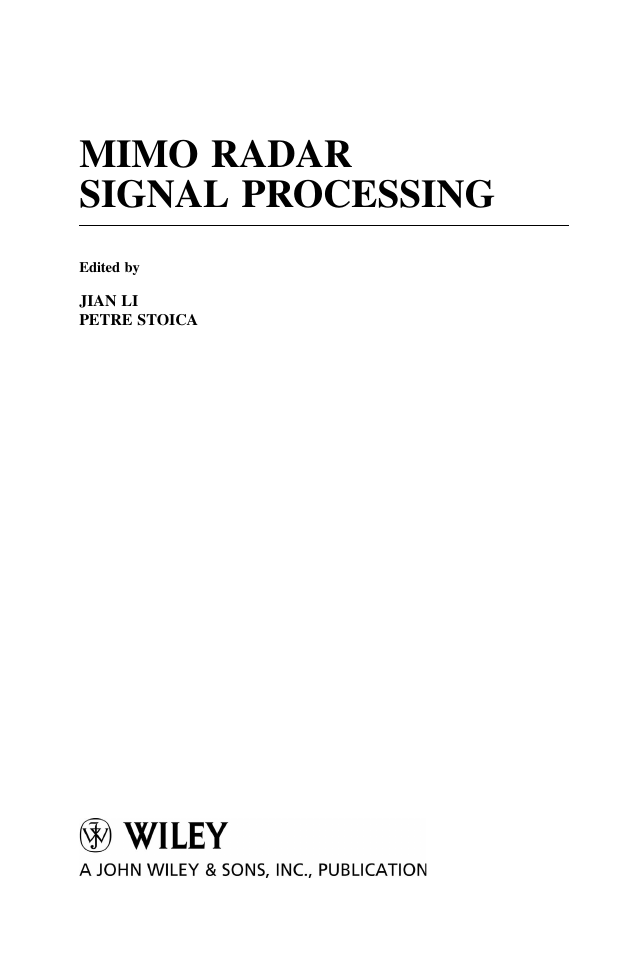

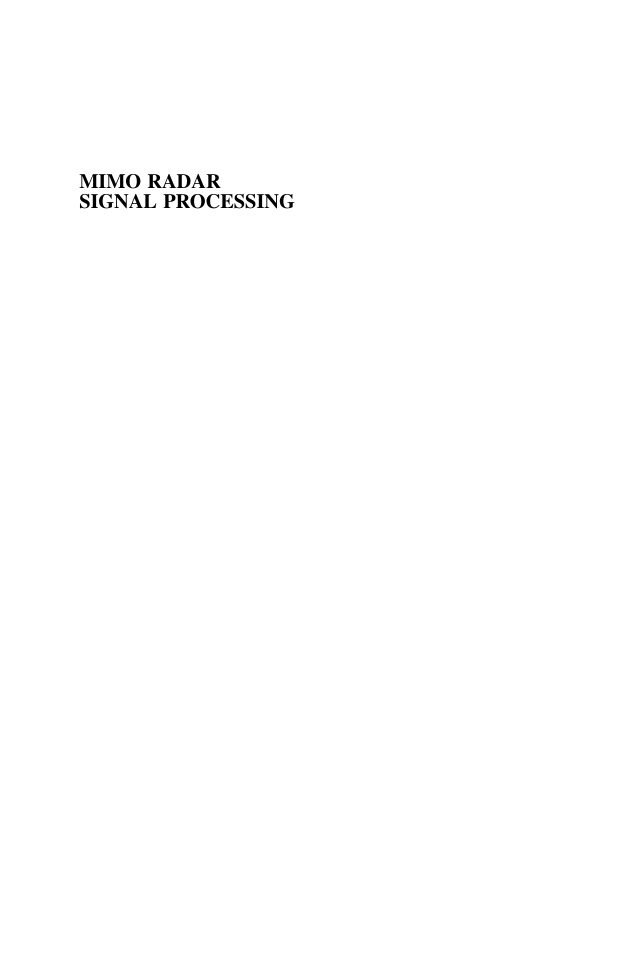

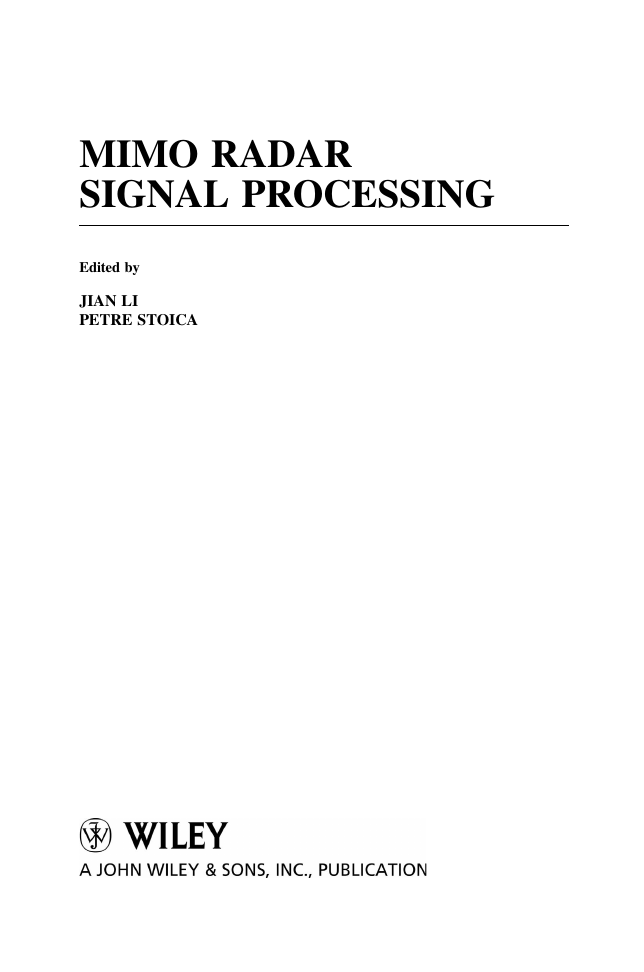
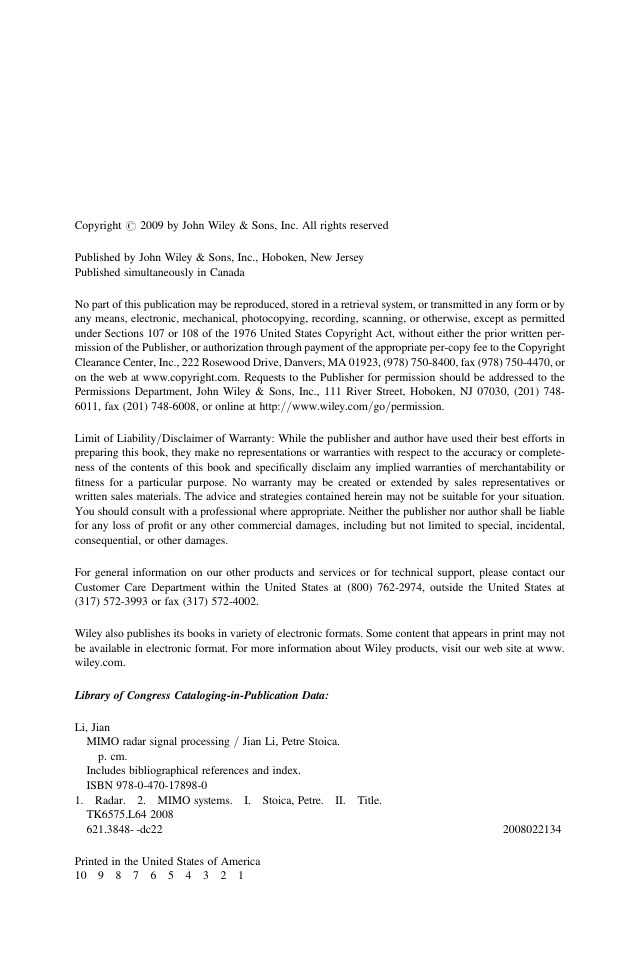
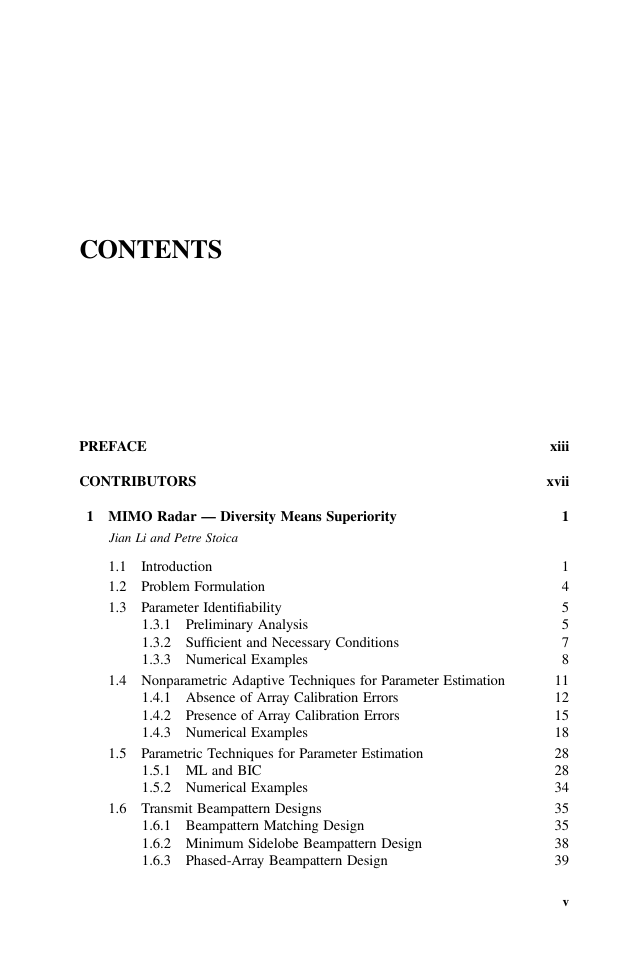









 2023年江西萍乡中考道德与法治真题及答案.doc
2023年江西萍乡中考道德与法治真题及答案.doc 2012年重庆南川中考生物真题及答案.doc
2012年重庆南川中考生物真题及答案.doc 2013年江西师范大学地理学综合及文艺理论基础考研真题.doc
2013年江西师范大学地理学综合及文艺理论基础考研真题.doc 2020年四川甘孜小升初语文真题及答案I卷.doc
2020年四川甘孜小升初语文真题及答案I卷.doc 2020年注册岩土工程师专业基础考试真题及答案.doc
2020年注册岩土工程师专业基础考试真题及答案.doc 2023-2024学年福建省厦门市九年级上学期数学月考试题及答案.doc
2023-2024学年福建省厦门市九年级上学期数学月考试题及答案.doc 2021-2022学年辽宁省沈阳市大东区九年级上学期语文期末试题及答案.doc
2021-2022学年辽宁省沈阳市大东区九年级上学期语文期末试题及答案.doc 2022-2023学年北京东城区初三第一学期物理期末试卷及答案.doc
2022-2023学年北京东城区初三第一学期物理期末试卷及答案.doc 2018上半年江西教师资格初中地理学科知识与教学能力真题及答案.doc
2018上半年江西教师资格初中地理学科知识与教学能力真题及答案.doc 2012年河北国家公务员申论考试真题及答案-省级.doc
2012年河北国家公务员申论考试真题及答案-省级.doc 2020-2021学年江苏省扬州市江都区邵樊片九年级上学期数学第一次质量检测试题及答案.doc
2020-2021学年江苏省扬州市江都区邵樊片九年级上学期数学第一次质量检测试题及答案.doc 2022下半年黑龙江教师资格证中学综合素质真题及答案.doc
2022下半年黑龙江教师资格证中学综合素质真题及答案.doc